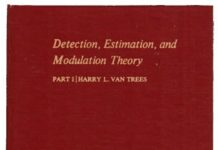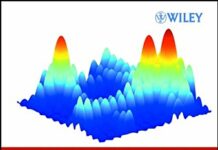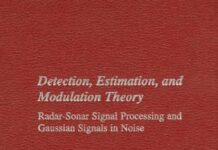
Ebook Info
- Published: 2013
- Number of pages: 1176 pages
- Format: PDF
- File Size: 8.86 MB
- Authors: Harry L. Van Trees
Description
Originally published in 1968, Harry Van Trees’s Detection, Estimation, and Modulation Theory, Part I is one of the great time-tested classics in the field of signal processing. Highly readable and practically organized, it is as imperative today for professionals, researchers, and students in optimum signal processing as it was over thirty years ago. The second edition is a thorough revision and expansion almost doubling the size of the first edition and accounting for the new developments thus making it again the most comprehensive and up-to-date treatment of the subject. With a wide range of applications such as radar, sonar, communications, seismology, biomedical engineering, and radar astronomy, among others, the important field of detection and estimation has rarely been given such expert treatment as it is here. Each chapter includes section summaries, realistic examples, and a large number of challenging problems that provide excellent study material. This volume which is Part I of a set of four volumes is the most important and widely used textbook and professional reference in the field.
User’s Reviews
Editorial Reviews: From the Inside Flap “Since 1968 and after 30 printings of the first edition, Part I of DEMT has been the textbook for the two generations of students and researchers that have designed the signal processing in many of our operational systems. The Second Edition includes subsequent advances, retains clarity of explanation, and promises to be the text and reference for future generations.” — Dr. Arthur B. Baggeroer, Ford Professor Emeritus, MITThe First Edition of Detection, Estimation, and Modulation Theory, Part I, enjoyed a long useful life. However, in the forty-four years since its publication, there have been a large number of changes:1. The basic detection and estimation theory has remained the same but numerous new results and algorithms have been obtained.2. The exponential growth in computational capability has enabled us to implement algorithms that were only of theoretical interest in 1968.3. The theoretical results from DEMT have been widely applied in operational systems.4. Simulation became more widely used in system design and analysis, research, and teaching.The Second Edition is a significant expansion of the first edition with 450 pages of new material. Chapter 2 in the First Edition, Classical Detection and Estimation Theory, is expanded into four chapters. Many more examples are developed in detail to enhance readability, and more non-Gaussian models are included. A large number of significant developments that are appropriate for an introductory text—including global Bayesian bounds, efficient computational algorithms, equivalent estimation algorithms, sequential estimation, and importance sampling—are added. The Fisher and Bayesian linear Gaussian models are studied in more detail. The First Edition emphasized continuous-time random processes. The Second Edition includes a comprehensive development of linear estimation of discrete-time random processes leading to discrete-time Wiener and Kalman filters. A brief introduction to Bayesian estimation of non-Gaussian processes is included. An expanded version of material from Part III develops optimum detectors for continuous-time and discrete-time random processes that can be implemented using Wiener or Kalman filters.As imperative today as it has been since its original publication in 1968, this work is sure to remain the leading reference for engineers who need to apply detection and estimation theory in diverse systems. From the Back Cover “Since 1968 and after 30 printings of the first edition, Part I of DEMT has been the textbook for the two generations of students and researchers that have designed the signal processing in many of our operational systems. The Second Edition includes subsequent advances, retains clarity of explanation, and promises to be the text and reference for future generations.” — Dr. Arthur B. Baggeroer, Ford Professor Emeritus, MITThe First Edition of Detection, Estimation, and Modulation Theory, Part I, enjoyed a long useful life. However, in the forty-four years since its publication, there have been a large number of changes:1. The basic detection and estimation theory has remained the same but numerous new results and algorithms have been obtained.2. The exponential growth in computational capability has enabled us to implement algorithms that were only of theoretical interest in 1968.3. The theoretical results from DEMT have been widely applied in operational systems.4. Simulation became more widely used in system design and analysis, research, and teaching.The Second Edition is a significant expansion of the first edition with 450 pages of new material. Chapter 2 in the First Edition, Classical Detection and Estimation Theory, is expanded into four chapters. Many more examples are developed in detail to enhance readability, and more non-Gaussian models are included. A large number of significant developments that are appropriate for an introductory text—including global Bayesian bounds, efficient computational algorithms, equivalent estimation algorithms, sequential estimation, and importance sampling—are added. The Fisher and Bayesian linear Gaussian models are studied in more detail. The First Edition emphasized continuous-time random processes. The Second Edition includes a comprehensive development of linear estimation of discrete-time random processes leading to discrete-time Wiener and Kalman filters. A brief introduction to Bayesian estimation of non-Gaussian processes is included. An expanded version of material from Part III develops optimum detectors for continuous-time and discrete-time random processes that can be implemented using Wiener or Kalman filters.As imperative today as it has been since its original publication in 1968, this work is sure to remain the leading reference for engineers who need to apply detection and estimation theory in diverse systems. About the Author HARRY L. VAN TREES, ScD., received his BSc. from the United States Military Academy and his ScD. from Massachusetts Institute of Technology. During his fourteen years as a Professor of Electrical Engineering at MIT, he wrote Parts I, II, and III of the DEMT series. On loan from MIT, he served in four senior DoD positions including Chief Scientist of the U.S. Air Force and Principal Deputy Assistant Secretary of Defense (C3I). Returning to academia as an endowed professor at George Mason University, he founded the C3I Center and published Part IV of the DEMT series, Optimum Array Processing. He is currently a University Professor Emeritus.KRISTINE L. BELL, PhD, is a Senior Scientist at Metron, Inc., and an affiliate faculty member in the Statistics Department at George Mason University. She coedited with Dr. Van Trees the Wiley-IEEE book Bayesian Bounds for Parameter Estimation and Nonlinear Filtering/Tracking.ZHI TIAN, PhD, is a Professor of Electrical and Computer Engineering at Michigan Technological University. She is a Fellow of the IEEE. Read more
Reviews from Amazon users which were colected at the time this book was published on the website:
⭐Very good service and product.Book has a complete information about modulation theory.I recommend this book for students of telecommunications
⭐Van Trees has been a classic for many years with the first edition landing in many hands of students and engineering professionals. It was almost shocking to me that the first edition was written over 40 years ago. But since the material provides the foundation for estimation and is primarily driven by mathematics that hasn’t changed much since Bayes first offered the idea of conditional probability, there probably wasn’t much that really needed to change. But with the explosion of microprocessor capability, things really have changed, making the instantiation of algorithms into real-time products commonplace. In addition, the engineering field has learned some things about the implementation of algorithms, often making system trades between hardware and software for these algorithms. Van Trees doesn’t really address any of this, but in this update, his former grad student has updated the text (under the supervision of Van Trees) with the mathematical foundation for algorithms that were problematic at the time of the first edition. For example, extended Kalman Filters had a history of instability until the necessary throughput was available to make these designs robust (along with some timely research into algorithm improvement such as the application of factorization methods). So, the book has some strategic additions to address topics like these, but does not go into the depth that motivates the history or projects the future.Overall, this is still an excellent reference for the theoretical foundation for detection and estimation. The update to the book does improve the original text, but in practice, there are literally hundreds of texts now that address this material as well. So, if you want a good reference for your shelf, this is a good addition. But I fully expect that the emerging students will use Wikipedia and other online resources to fill their theoretical gaps (as much as that can be done). It was almost impossible to take this classic text/reference and get anything lower than four stars, but the authors did very little to push it up to five. But I’m still very happy to have this book on my shelf (although I wish their section on Bayesian estimation was “beefed” up … apparently you have to buy a totally separate book.
⭐This series (Part I and Part II) are classic reference books for engineers. I describe the text as academic because the focus on on theory. There is no other singular text or series that covers in depth the theory demonstrated and sometimes explained in the text.Although the authors indicate that a solution manual that includes Matlab scripts is available (by emailing the authors or publisher), there is attempt to include the scripts in the text (although graphs created with Matlab are shown in the book).Overall I find that the text would be very appropriate to accompany academic studies or study with a mentor. That is, although the authors provide a comprehensive overview of theories, there is little explanation — for example — of the history of filters, modulation theory, and especially of applications.As an engineer, I find it easiest to follow examples that have a practical use for an application that I understand — say a receiver for a cable modem, or a receiver for a cell phone, etc. Clearly the authors did not intend to cover implementation as the title obviously says theory.In summary, an indispensable reference, but I’m giving it only 4 stars because in this new edition either the authors or the editor could have included at least one appendix if not text/sidebars throughout the book with examples in Matlab (or MathCAD) which would have dramatically improved the utility of the book. It’s disappointing not to see such value in a ‘updated’ second edition.A quick follow up, several days shy of 6 months after I wrote to the email address listed, I did get an email back from the author with information on how to find the Matlab examples online. The examples are there, organized and ready to use in Matlab.
⭐It is remarkable and laudatory that Trees has lived at least 44 years after his first edition was published. In the introduction to this second edition, you can appreciate how the engineering world has vastly changed with the awesome growth of computing power. That in essence explains the voluminous heft of this edition. Now, broadly, the book encapsulates both analytic theory and numerical methods, in a self reinforcing manner. The first edition of necessity had to emphasise analytic methods due to the paucity of existing computers.The current book can be used for an entire year’s course on this subject. Each chapter is replete with problems that can be assigned to students.Even so, the sheer length of the text may mean de facto that it is used more as a reference than for a course.Unsurprisingly, Gaussian random processes are the favoured random process, due to the Central Limit Theorem. And partly for reasons of analytic simplicity, noise is typically taken to be an additive random process that is combined with a signal. Both assumptions are also used by default in shorter texts. But this book offers a far more comprehensive treatment.
⭐
⭐
⭐
⭐
Keywords
Free Download Detection Estimation and Modulation Theory, Part I: Detection, Estimation, and Filtering Theory 2nd Edition in PDF format
Detection Estimation and Modulation Theory, Part I: Detection, Estimation, and Filtering Theory 2nd Edition PDF Free Download
Download Detection Estimation and Modulation Theory, Part I: Detection, Estimation, and Filtering Theory 2nd Edition 2013 PDF Free
Detection Estimation and Modulation Theory, Part I: Detection, Estimation, and Filtering Theory 2nd Edition 2013 PDF Free Download
Download Detection Estimation and Modulation Theory, Part I: Detection, Estimation, and Filtering Theory 2nd Edition PDF
Free Download Ebook Detection Estimation and Modulation Theory, Part I: Detection, Estimation, and Filtering Theory 2nd Edition


